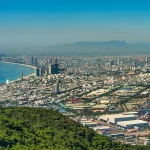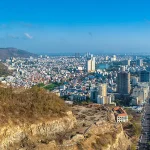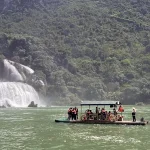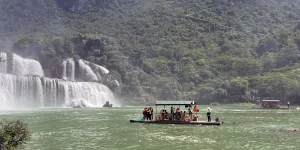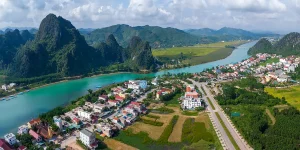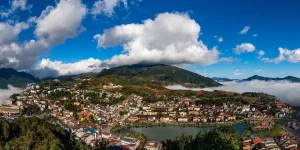Bridges in Vietnam are more than just ways to cross rivers. Some are engineering marvels, others are cultural landmarks, and a few are simply built for the view. In this guide, we’ll walk you through the 12 Best Bridges in Vietnam to Visit as a Tourist—the ones you’ve likely seen on postcards, travel vlogs, and even your banknotes.
But we’re not just talking about beauty and fame. Some of these spots offer breathtaking panoramas for pedestrians, even if the bridge itself isn’t especially stunning. Others surprise you with unexpected details, history, or just plain odd charm.
Let’s dive in—starting with a fire-breathing dragon, a world-famous pair of giant hands, and a postcard-perfect wooden arch in one of Vietnam’s most charming towns.
Table of Contents
The Most Famous Bridges in Vietnam

Dragon Bridge in Da Nang
A fitting place to start is the Dragon Bridge in Da Nang, easily one of the most recognizable bridges in Vietnam. Designed to look like a golden dragon stretching across the Han River, it’s both a functional road bridge and a popular attraction.
Every weekend night, the dragon comes to life—breathing fire and water in a show that draws large crowds. The performance starts at 9:00 PM every Saturday and Sunday. To get a good viewing spot, it’s best to arrive at least 20–30 minutes early.
You can watch from the bridge itself to get up close (and maybe a little wet). Or stand on the nearby riverbank for a wider perspective.
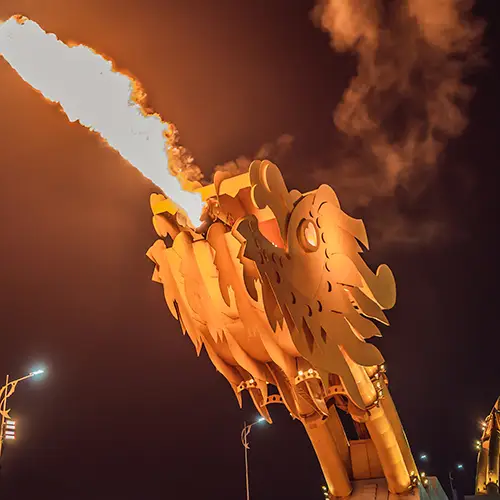
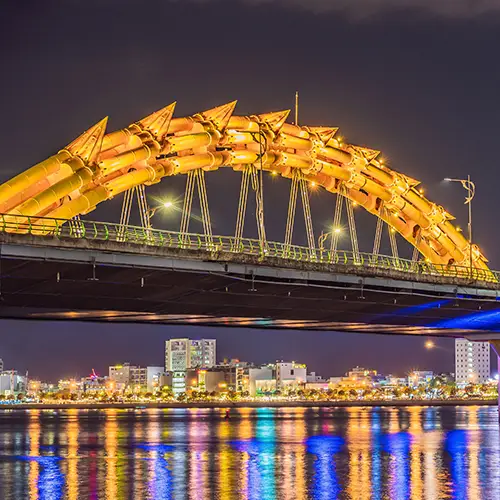

For a bonus, grab a bite at the Son Tra Night Market just by the bridge’s eastern end. It’s a lively spot full of seafood grills, souvenirs, and fresh sugarcane juice.
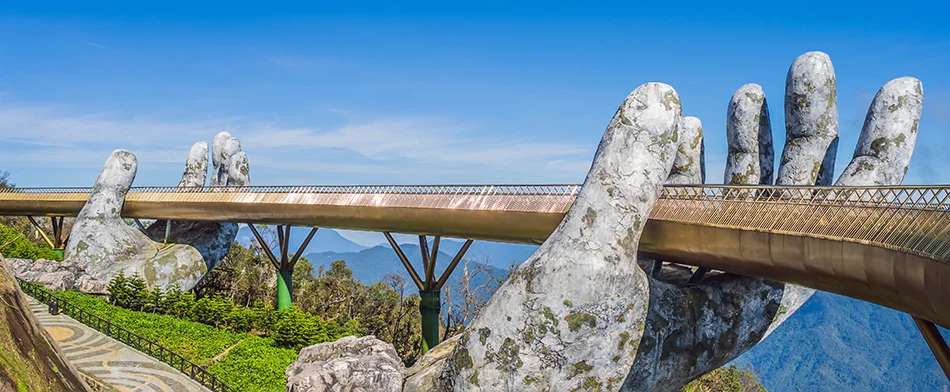
Golden Bridge, Ba Na Hills, Da Nang
You’ve almost certainly seen it: a golden walkway held up by giant stone hands that look centuries old. In photos, it gives the impression of an ancient ruin discovered in the clouds. But in fact, the Golden Bridge in Ba Na Hills is a modern construction. It was completed in 2018 as part of a mountaintop theme park located about 45 minutes from Da Nang.
Though it isn’t historic, the Golden Bridge has become one of Vietnam’s most photographed tourist attractions. Technically, it qualifies as a bridge, though it doesn’t span any river or valley. Instead, it curves along a manicured hillside, designed purely for visual impact. And to be fair, the impact is real—it’s one of the best places to visit in Vietnam, especially for travelers chasing unique views and unforgettable photos.
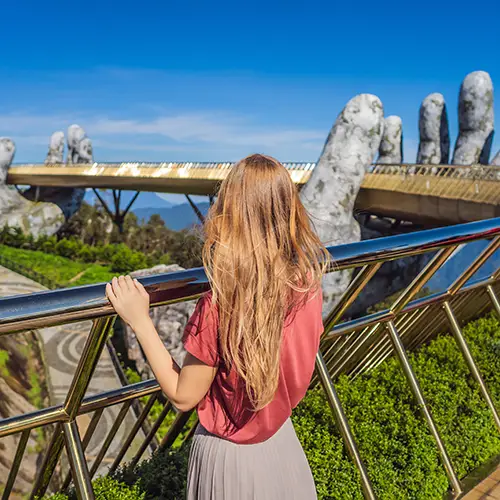
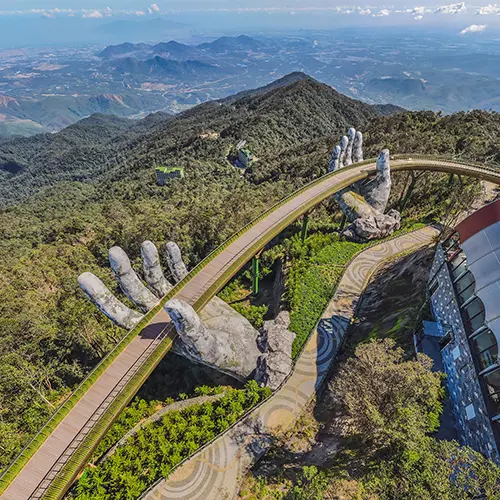
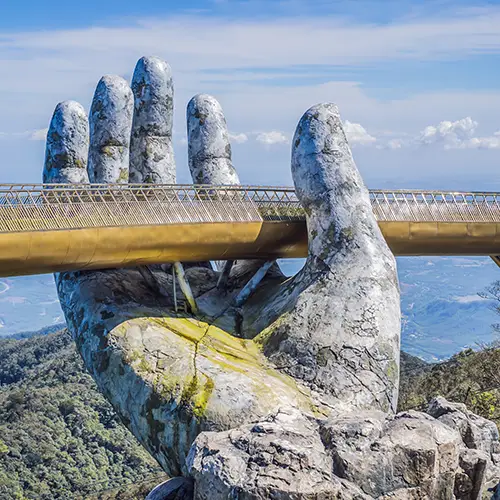
The bridge sits inside the Sun World Ba Na Hills complex, and visiting requires a paid ticket that includes the cable car—around 900,000 VND (~$35). You can reach the park by shuttle, motorbike, or private tour from Da Nang. To avoid the largest crowds, aim to go early on a weekday.
One common question from visitors is whether it’s possible to see the bridge from a distance without entering the park. The answer is no—the Golden Bridge is located high in the mountains, with no public roads or outside viewpoints. The only way to access it is by purchasing a ticket and riding the cable car into the park complex.
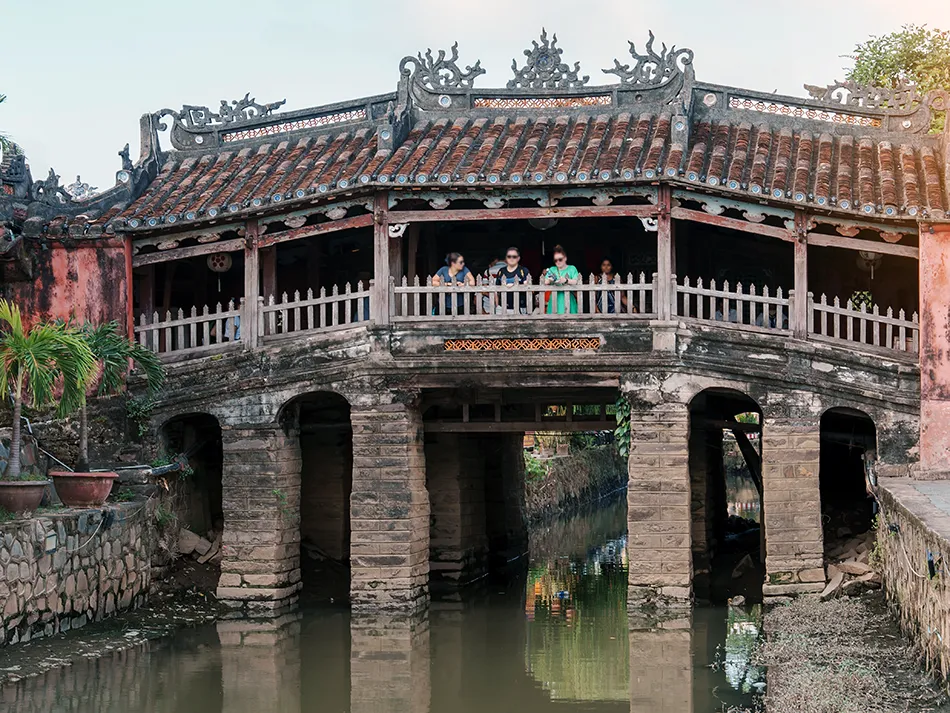
Japanese Covered Bridge – Hoi An
Right in the heart of Hoi An Ancient Town, the Japanese Covered Bridge is one of Vietnam’s most charming landmarks—and yes, it even appears on the 20,000 VND note. The bridge was built in the 17th century by the Japanese community that once lived in Hoi An. Its design blends Vietnamese, Japanese, and Chinese architectural styles, with a wooden pagoda roof and detailed carvings.
What makes this small bridge special isn’t its size or engineering but its symbolism and serenity. It once connected the Japanese and Chinese quarters of the town, serving as both a literal and cultural link. Today, it’s a photo favorite for visitors and a quiet reminder of Hoi An’s past as a bustling port.
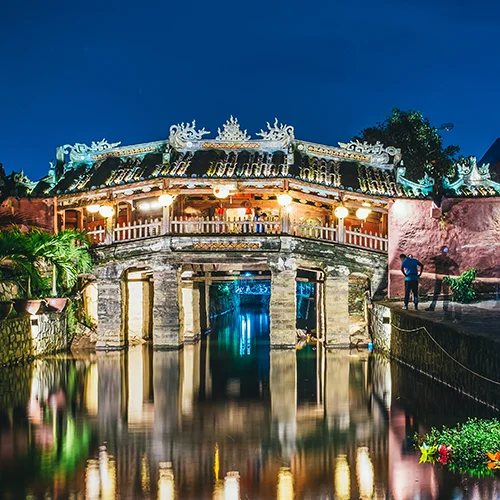

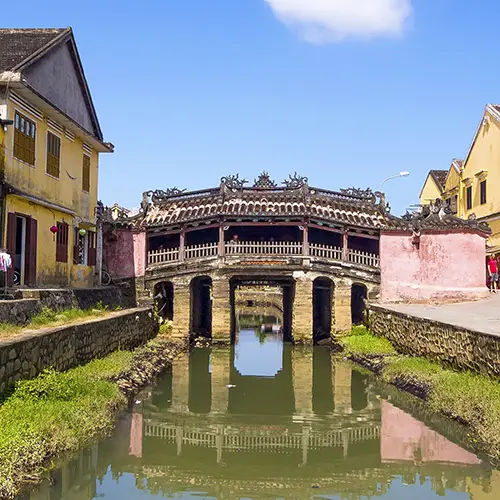
A fun fact? Inside the bridge, there’s a small shrine dedicated to Tran Vo Bac De, the Taoist god believed to control the weather. It’s a fitting detail for a structure that has stood through centuries of storms.
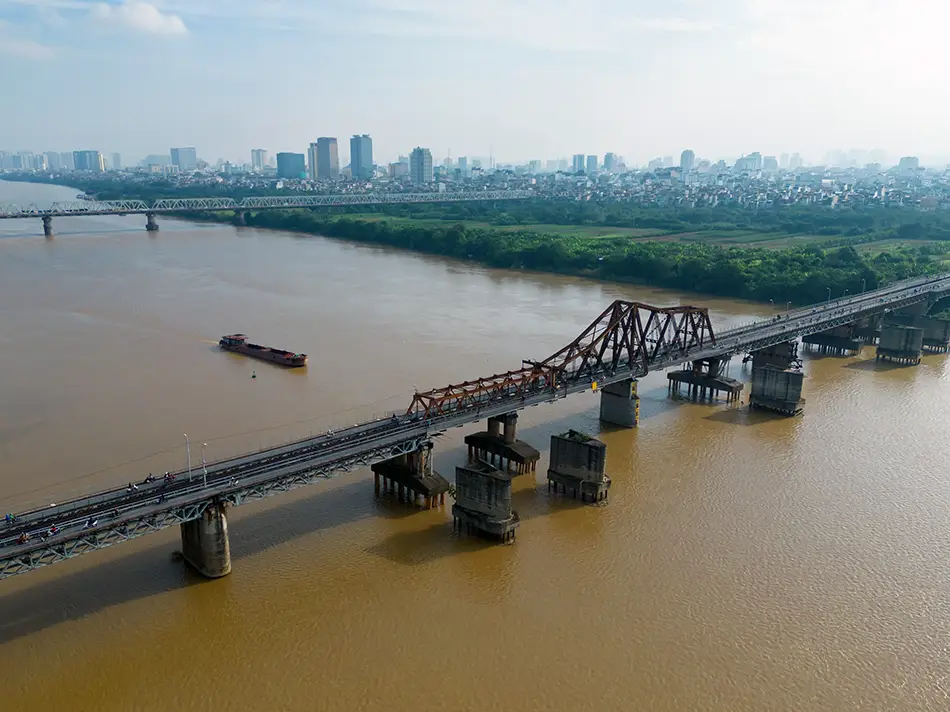
Long Bien Bridge – Hanoi
Let’s be honest: we’ve included the Long Bien Bridge on this list for one reason only—every other travel website does. And that, in a way, earns it a spot among the most famous bridges in Vietnam. But if you ask us why it’s so widely featured, we’ll be honest again: we’re not quite sure.
The bridge itself is… not much to write home about—unless you have a soft spot for aging steel and rusted rail tracks. It’s often wrongly credited to Gustave Eiffel, but that’s just a myth. The French built the structure in 1902. At the time, it was the longest bridge in Southeast Asia. That might explain the attention. Or maybe the legend stuck.
From today’s perspective, it’s just another old railroad bridge—not so different from many others around the world. No striking arches. No bold design. Just a long stretch of steel with a train track down the middle and narrow lanes for motorbikes and pedestrians alongside.
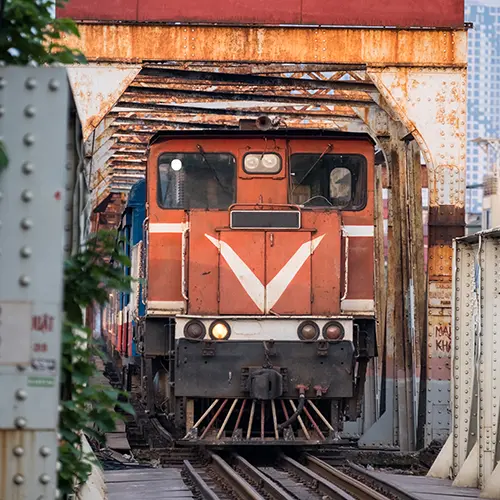
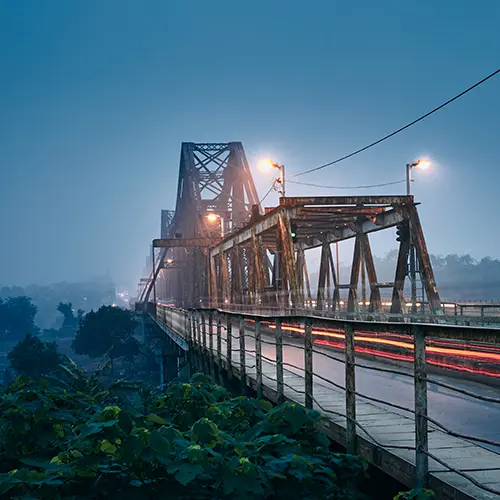
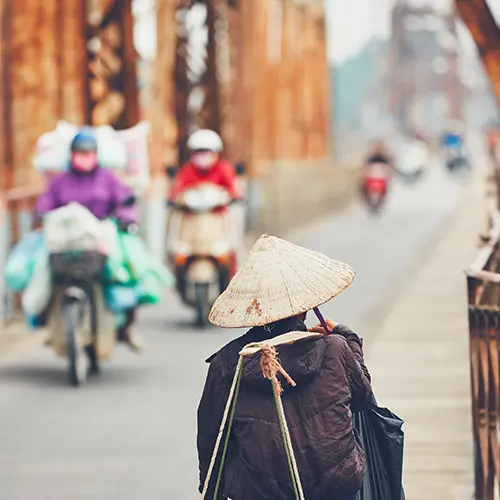
But still, there’s something authentic to be found here. If you walk along the narrow pedestrian path toward the center of the bridge, pause for a moment. You’ll be standing just next to the motorbike lane—separated by less than a meter. From that close distance, you can watch a steady stream of bikes pass—some carrying entire families, others loaded with stacked goods or supplies. It’s loud, fast, and completely ordinary—but in that moment, you get a raw, unscripted look at how the city moves.
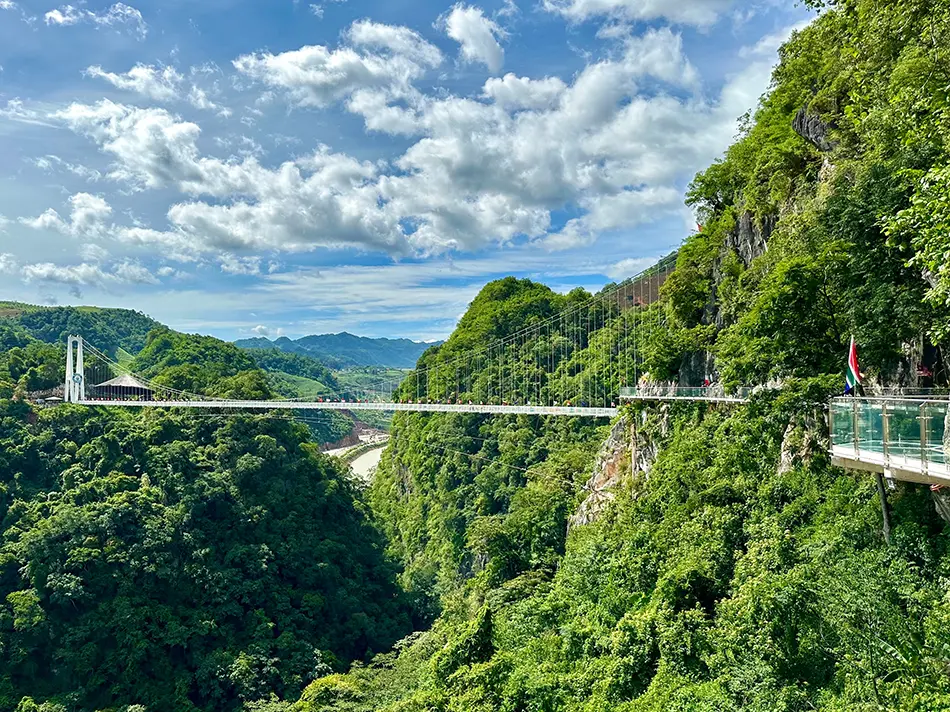
Bach Long Glass Bridge – Moc Chau
Now for something completely different—and brand new. The Bach Long Glass Bridge, located in the mountains of Moc Chau, Son La Province, is a jaw-dropper. Stretching over 2,000 feet (632 meters) with a height of 490 feet (150 meters) above the jungle. It holds a Guinness World Record as one of the longest glass-bottom bridges in the world.
The bridge is made with three layers of tempered glass, strong enough to hold hundreds of people at once. But don’t worry, it’s designed to feel scary. The thrill comes from looking straight down and realizing how little separates you from the drop. Just a pane of glass stands between you and the green valley below.
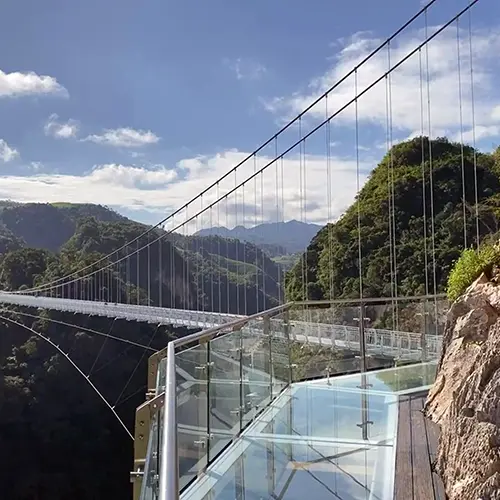


Entry to the bridge costs around 650,000 VND (~$25), and it’s located inside the Moc Chau Island tourist complex, which includes gardens, rope bridges, and themed photo zones. To get there, your best bet is traveling from Hanoi (roughly 5–6 hours by car or bus). It’s ideal as part of a weekend trip, and definitely not for the faint of heart.
Whether you’re into daring heights or just want a unique photo, this is currently the bridge with the best view—as long as you can stomach it.
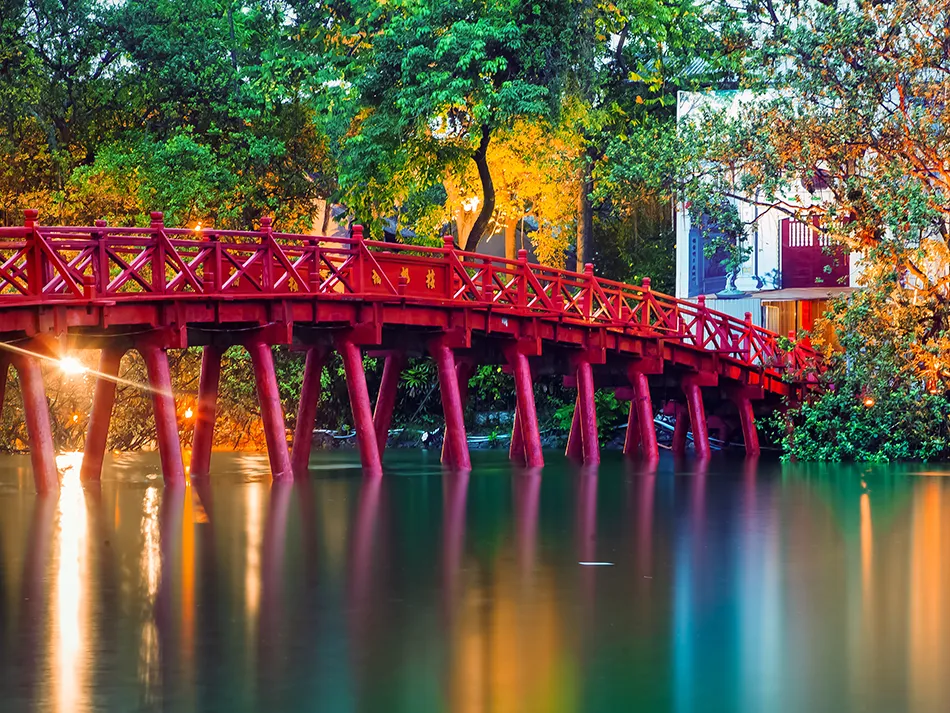
The Huc Bridge – Hanoi
Located on Hoan Kiem Lake in central Hanoi, The Huc Bridge is a short, bright-red wooden bridge.
It connects the lakeshore to Ngoc Son Temple, a small island shrine. Despite its modest size, the bridge is one of the city’s most recognizable landmarks and draws visitors throughout the day.
Built in the 19th century, the bridge is constructed in classical Vietnamese style, with gentle curves and lacquered wooden railings. It was designed for pedestrians only and remains closed to vehicles. Today, it serves as the main access point to the temple, which is dedicated to General Tran Hung Dao. A military figure known for resisting Mongol invasions in the 13th century.
The Huc Bridge is especially popular at sunrise and in the evening, when its reflection creates a calm scene on the lake’s surface. While not grand in scale, it’s a well-maintained structure that plays both a practical and symbolic role in Hanoi’s cultural center.
Visitors can cross the bridge with a ticket to Ngoc Son Temple (about 30,000 VND / ~$1.20). It’s an easy and worthwhile stop for anyone walking around the Old Quarter or visiting the lake.
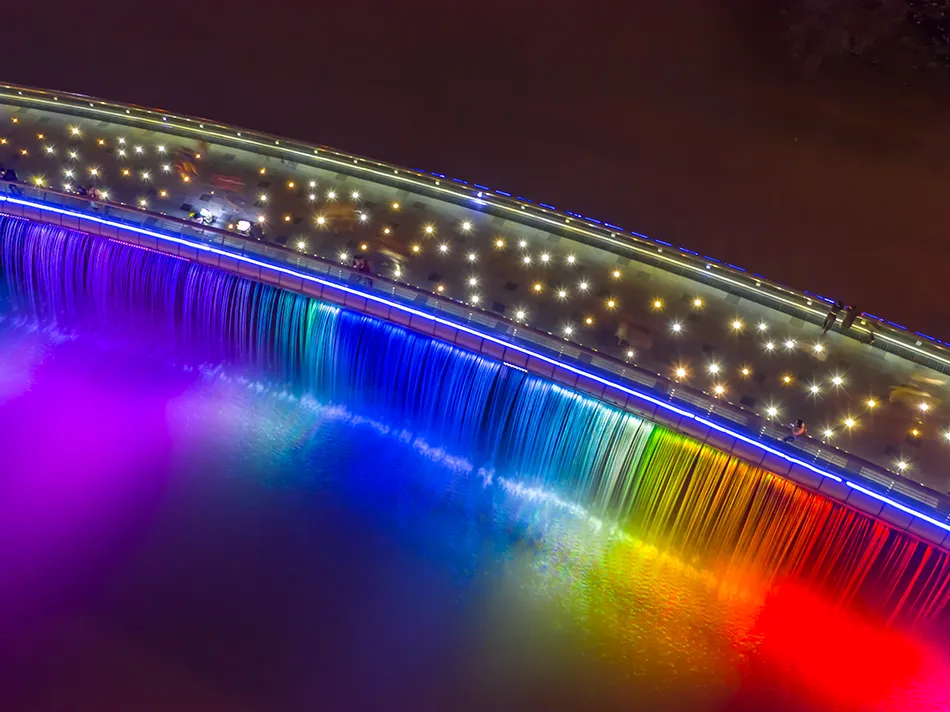
Starlight Bridge – Ho Chi Minh City
Wrapping up our list is a bridge that feels like it belongs in a sci-fi movie. The Starlight Bridge (Cầu Ánh Sao) is a pedestrian-only bridge located in the Phu My Hung area of Saigon’s District 7. By day, it’s pleasant. By night, it shines—literally.
As soon as the sun sets, the walkway lights up with hundreds of embedded LED lights, mimicking stars under your feet.
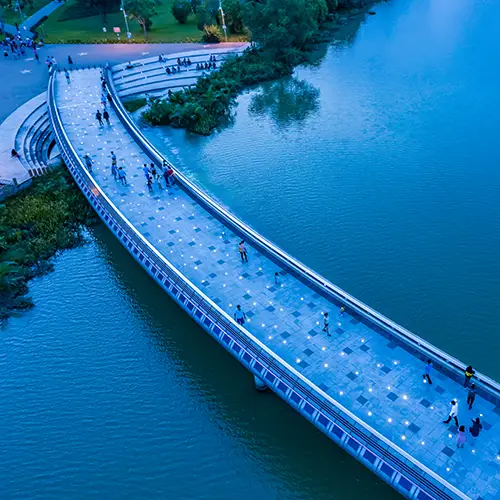
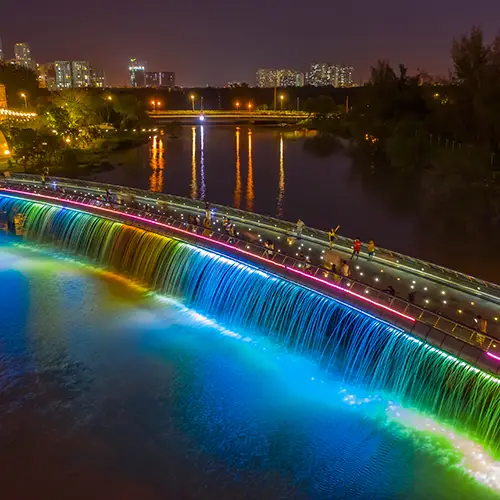

It’s a pleasant walk and an interesting bridge to see, especially if you’re already in the area. Set in one of the city’s most upscale neighborhoods, it’s popular with locals and rarely crowded with tourists—making it a relaxing way to end the day.
Bridges in Vietnam Worth Visiting for the View
Some bridges in Vietnam stand out simply for what you can see from them. They might not be the most famous or photographed, but if you’re after open views of cityscapes, rivers, or daily life unfolding below, these bridges are worth a walk—or at least a pause.

Truong Tien Bridge – Hue
Crossing the Perfume River in central Hue, Truong Tien Bridge offers a full view of both riverbanks and the low, traditional skyline of the city. You’ll see boats moving slowly along the water, tree-lined embankments, and the imperial city’s calm rhythm in the distance.
It’s not a high bridge, but the perspective is wide and unobstructed. Especially at the end of the day, it becomes a popular spot for locals. Many walk or cycle across to enjoy the view over the river.
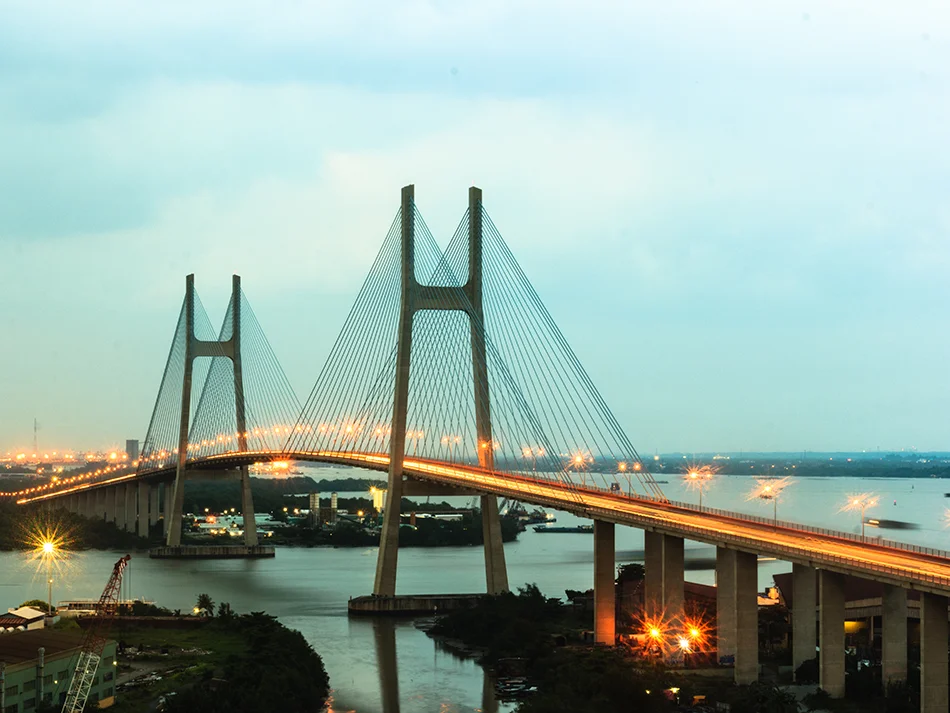
Phu My Bridge – Ho Chi Minh City
Phu My Bridge spans the Saigon River, connecting District 7 to the industrial areas on the eastern side of the city. From the top, there’s a broad view of the river below, shipping routes, dockyards, and, in the distance, parts of the city skyline.
It’s not a pedestrian-friendly bridge in the usual sense. But if you pass by or stop nearby, the view gives you a sense of how the city is expanding outward. The river clearly plays a central role in that growth.
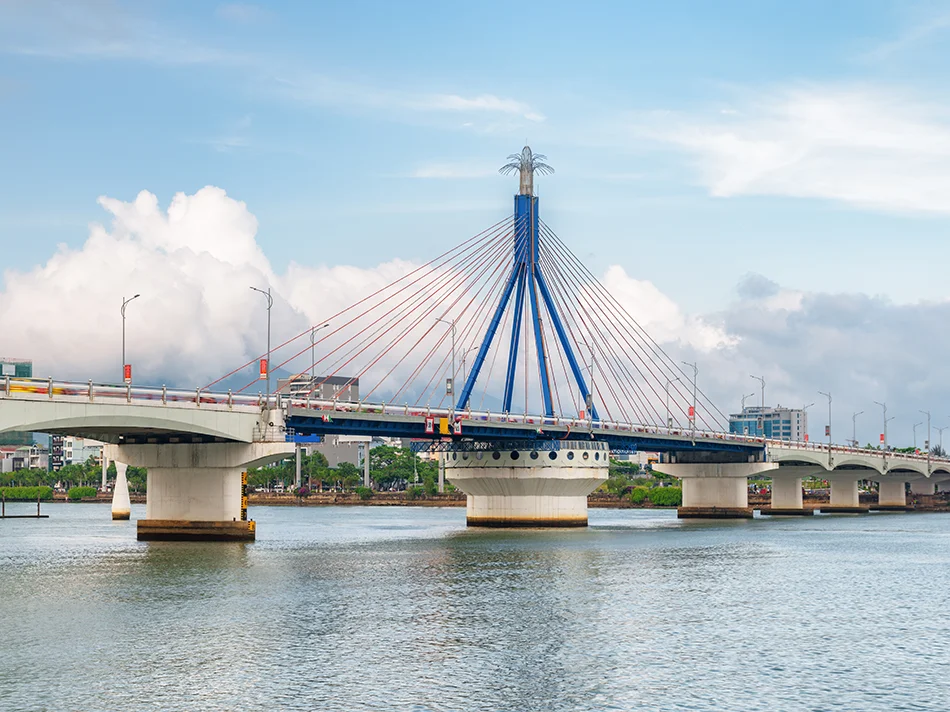
Han River Bridge – Da Nang
Han River Bridge sits right in the middle of Da Nang. It gives you a clear line of sight in both directions along the river.along the river. Looking west, you’ll see the city center and the surrounding hills. To the east, there’s a view toward the sea, with bridges like Dragon Bridge and Tran Thi Ly Bridge nearby.
The bridge is easy to walk across. From either side, you can stop and take in the constant motion on the river—boats, lights, people, and traffic. It’s a good way to get your bearings in the city and take in a panoramic slice of urban life.
Bridges with History
While some of the bridges above are known for their bold design or panoramic views, others stand out for a different reason. They may not be as visually impressive or frequently photographed, but they carry historical weight. These bridges played specific roles during Vietnam’s colonial period, wartime years, or political transitions. They’re meaningful stops for travelers interested in the country’s more complex past.
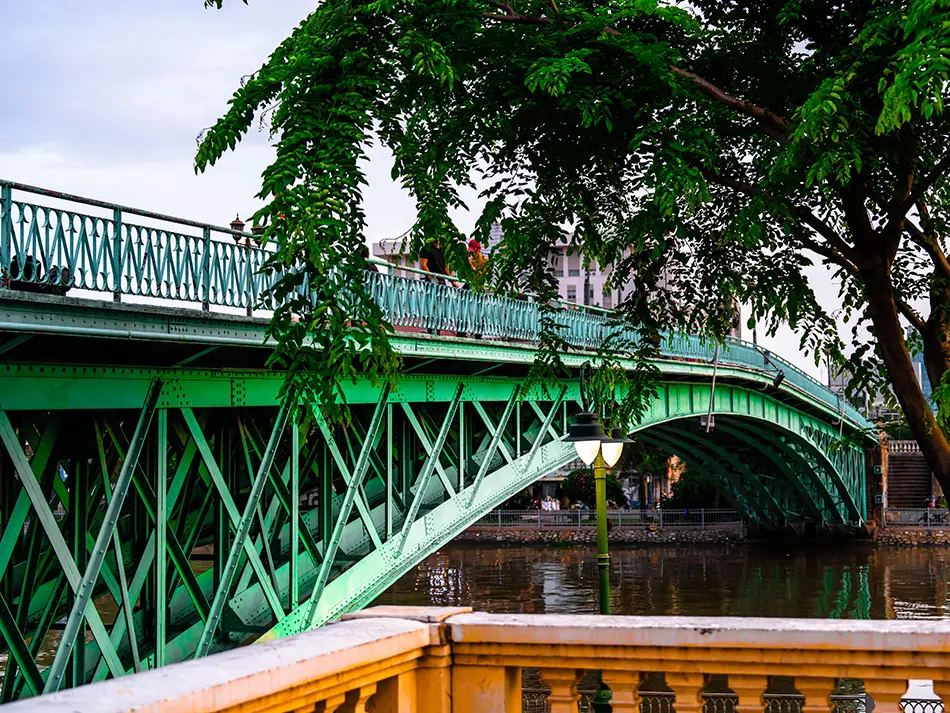
Mong Bridge – Ho Chi Minh City
Mong Bridge is the only bridge in Vietnam confirmed to have been constructed by the Gustave Eiffel engineering agency. It was built in 1893–1894 for the Messageries Maritimes, a major French shipping company. It connected Saigon’s commercial port with the colonial administrative zone across the Ben Nghe Canal, serving both logistical and urban planning needs during the French colonial period.
The bridge was dismantled but was later rebuilt using modern materials while faithfully preserving the original steel-arch design. Though it’s no longer the original structure, it remains a true architectural replica. It offers a rare example of 19th-century French engineering in modern-day Ho Chi Minh City.Today, it is reserved for pedestrians and cyclists, providing a low-traffic perspective on the city’s colonial past.

Hien Luong Bridge – Quang Tri Province
Located in Quang Tri Province, the Hien Luong Bridge is one of the most politically significant bridges in the country. From 1954 to 1975, it marked the 17th parallel—the temporary border between North and South Vietnam under the Geneva Accords. Control of the bridge was split evenly between the two governments.
To visually assert this division, each side painted their half in a different color—blue for the North, yellow for the South—and installed loudspeakers to broadcast propaganda across the river. The bridge became both a strategic checkpoint and a symbol of the country’s division during the Vietnam War.
Today, Hien Luong is preserved as part of a memorial site and features in most DMZ (Demilitarized Zone) tours, offering visitors a direct encounter with a location that once stood at the heart of geopolitical tension in Southeast Asia.
Exploring Vietnam, One Bridge at a Time
We hope this guide has helped you discover a different side of Vietnam—one that goes beyond the usual tourist stops. From city highlights to lesser-known spots with a story, these bridges offer more than a place to cross—they offer a reason to pause and take in what’s around you.

Whether you’re planning your route or already on the road, keep this list in mind. Some of these bridges are easy to reach, others take a bit of planning—but all of them add something special to your journey.
So walk them, photograph them, or just stand still for a moment. However you experience them, Vietnam’s best bridges are part of what makes traveling here so rewarding. Enjoy the journey—and safe crossings ahead.


